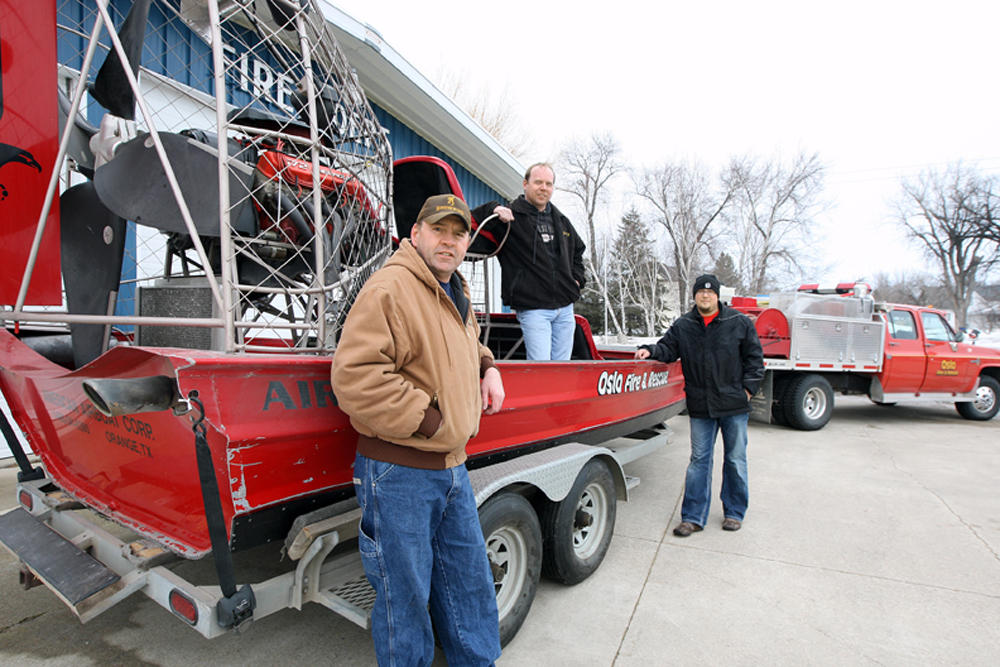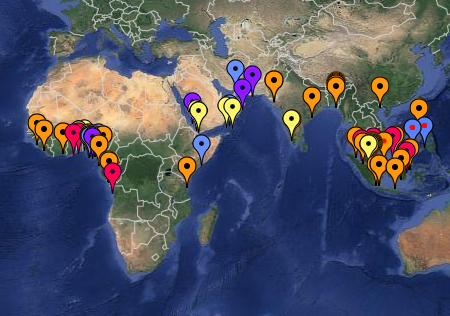a flood-fighting machine
By: Ryan Bakken, Grand Forks Herald
Published March 19, 2011, 08:42 PM
OSLO, Minn. — Flooding here is more horizontal than vertical. While rivers elsewhere rise, the one here mostly spreads wider in this flat country.
In 2009, the Red River here was 12 miles wide. Roads over 200 square miles were underwater and impassable.
Because of that topography, the most important flood-fighting equipment is not a sand bag machine or a backhoe. It’s an airboat.

Orin Knutson, Eric Nice and Troy Solem (left to right), the three main airboat drivers with the Oslo, Minn. volunteer fire and rescue department, say the would be lost with out the airboat and would need to call the Coast Guard or a helicopter in an emergency. Herald photo by John Stennes.
Name: Orin Knutson
Age: 52
Family: Daughter Larissa (18)
Home: Oslo
When not a flood fighter: Farmer
Flood fighter equipment: Airboat
Flood fighter duty: Airboat driver
Best flood memory: “We took Salvation Army workers for a ride and we all got damp.”
Worst flood memory: “We were underdressed and out for 14 hours in the wind and cold helping a power company restore power.”
One of the three main airboat drivers is 52-year-old Orin Knutson of Oslo’s 30-member volunteer fire and rescue department.
“We’d be totally lost without it,” Knutson said. “Without it, we’d have to call in the Coast Guard or a helicopter in an emergency.”
The airboat gets its name because it’s propelled by air. It’s a watercraft that’s popular in the Everglades.
Providing the air is an airplane propeller and a 572 cubic-inch, 750-horsepower engine. It’s the same engine that is used in drag racing. When started, it can be heard from 5 miles away.
The airboat’s body is shaped like a duck boat, with a thick hull made to withstand riding atop ice and roads.
“It has a foot throttle, but no brakes and no reverse,” Knutson said.
Although it’s capable of going 45 mph, it’s usually driven at slower speeds by Knutson, Eric Nice and Troy Solem. During high water, each day’s first duty is to pick up the postmaster and bank tellers from their rural homes, so the Oslo post office and bank can operate.
Then they deliver necessities such as medications, gas, food, generators, sandbags and occasionally mail. In 2009, the boat had more than 100 engine hours, the majority of them spent helping power companies restore electricity. The airboat was powerful enough to pull two miles of cable.
Everywhere the boat operators went, they basked in deep appreciation: verbal thanks, tears and material forms of gratitude such as freshly baked cookies and 12-ounce beverages.
“Sometimes it was hard to get away because they were lonely and wanted to talk to another human being,” Knutson said. “Having us show up also was a big stress-reliever because they realized they could count on us to get them out if it came to that.”
After a few weeks, cabin fever and anxiety motivated some rural residents to take the boat to civilization. “We’re not a taxi service,” Knutson said, “but we’ll get people out if they need to leave.”
The $34,000 purchase, a joint undertaking in 2008 by the city, five townships and fire and rescue, was met by a legion of local naysayers. But that attitude changed a year later.
“We had lot of doubting Thomases about the need for it, but after 2009, I had two people apologize and thank me,” Knutson said.
Although the investment was made for practical purposes, he also can’t help feeling like a kid with a new toy.
“It’s amazing what it’s accomplished,” Knutson said, “but there’s an adrenalin rush to driving it, too.”


